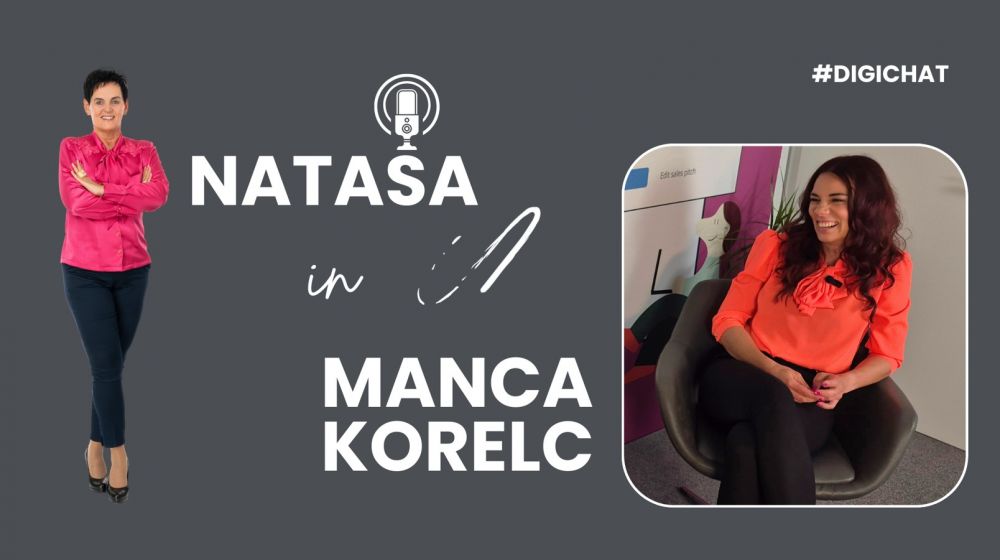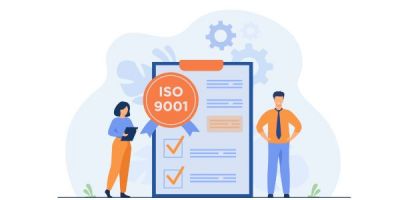Turn LinkedIn in your favour - Interview with Manca Korelc
It's no secret that LinkedIn is the leading platform for professional networking. We've been on it for years, networking with varying degrees of success, depending on how seriously we take it and how passionately we keep up with the constant changes the platform introduces.
Nataša Centa, an expert in digitalization of HR processes, talked with Manca Korelc, a LinkedIn specialist, author, and consultant, about how to use LinkedIn (LI) as a tool for career development and gaining a competitive edge in a frequently saturated job market. They also discussed how employers use LinkedIn to find the best talent.
Manca is a good-natured, communicative, and active businesswoman who needs no further introduction to most people. She is constantly in action, providing consultations, training, and collaborating with various companies and individuals in the LI domain. She describes herself as someone who cannot stay still, driven by constant innovation, and drawn to the digital and virtual world that offers unlimited possibilities for personal and professional interaction. A sports enthusiast at heart, she says:
»Professionally, I primarily focus on LinkedIn, but in my private life, I’m also active on Facebook and Instagram, where the content of my posts is completely different. For seven years, I’ve been working on the Slovenian Lakes project to introduce people to all the lakes in Slovenia, and recently, I’ve added waterfalls and hills with views of lakes to this project. Even in my professional presentations, I always mention this passion because it’s who I am.

So, we don't post everything on LinkedIn?
»We must understand that LinkedIn is primarily a professional environment, and accordingly, we should consider what types of content are suitable for this platform. The content should mainly pertain to our work and be useful to those who read it, our professional LinkedIn network: business partners, employees, clients, and colleagues. For other social networks, different content is appropriate, and I separate this. Occasionally, I might add a personal photo on LinkedIn to show another side of myself, but this is rare.
How would you summarize the main tips from your LinkedIn book for those who haven't read it yet?
»The most important thing about posts is to "sell" the post with text in the first three lines, which function like headlines in newspapers, magazines, or email subjects. It's essential to capture interest right at the start. Another tip is that posts should offer something in terms of information, knowledge, or inspiration, regardless of length. They should always be well-supported graphically. Photos of people work best since we remember faces and thus the content better. Another tip for LinkedIn profiles: whether personal or company profiles, the LinkedIn profile should tell something (not everything) about ourselves, but not for ourselves, for those who want to know us, collaborate with us, or follow us. When creating a LinkedIn profile, imagine having three minutes in a sales meeting to present yourself. This is what we post on our profile, and it is enough. LinkedIn profiles should not be treated like resumes.
How to prepare a LinkedIn profile?
»Remember a few things: whether we are running a personal profile as a job seeker or as an HR professional, or running a company profile, we need to research what interests and attracts our target audience and what they are looking for. If we include this added value in our profile, the chances of being seen and read increase significantly.
How important is LinkedIn as a tool for finding candidates or jobs?
»I believe that an HR professional without a LinkedIn profile is not the most successful HR professional. Likewise, I am convinced that LinkedIn is a powerful tool for job searching. However, having a profile is not enough. We need visibility and credibility. We must be active to achieve visibility: liking, commenting, networking, and we must be credible, which we achieve through posts. But we can't just post anything because LinkedIn networking is at a professional level. We need to post and write about things we want to "sell" or want our target audience to receive. We post content relevant to our audience—educational content, in short. Writing professional content is not easy as it requires time and energy.
We can be passively or actively present on LinkedIn. Being passive means having a well-maintained profile, updated achievements, maintaining, and expanding our network. Being active means regularly following posts in our network, liking, commenting, and posting relevant content.
In workshops I conduct, I often advise job seekers to choose and list ten companies where they would like to work, follow them on LinkedIn, find their employees and connect with them, engage in conversation by commenting and initiating conversations whenever appropriate. This opens up networking opportunities both online and offline, which can bring the desired results. On the other hand, HR professionals use LinkedIn's search filters to monitor potential candidates by content and also connect and establish initial contacts.
The hardest thing seems to be overcoming the mental barrier that establishing contact via LinkedIn is harder than in person. It is not the same, but it is quite similar, and if we want to be successful, we need to understand and embody this.
Are there pitfalls on LinkedIn we should be aware of?
»My first response is this: LinkedIn brings much more benefits than pitfalls. With that in mind, like any other digital platform, it has pitfalls. The most visible pitfall is the gap between reality and LinkedIn reality. What does that mean? When an HR professional searches for a specific candidate profile, a very good professional might fall off their radar simply because they do not have a well-maintained LinkedIn profile and the search engines miss them. Conversely, candidates with fantastic LinkedIn profiles who meet all the criteria may turn out differently in reality during an in-person meeting, failing to meet expectations.
If we transfer this to job seekers, the picture is similar. Many companies on LinkedIn post about their outstanding activities, achievements, and care for their employees, but the reality may be entirely different. Conversely, companies that could be good for career development do not invest enough in their LinkedIn presence.
I would also highlight another potential trap if not well thought out. If we build all the company's LinkedIn activities around one person, one employee, one "ambassador," and that person leaves the company, we are left with nothing. Therefore, it makes sense to have multiple ambassadors or involve several different employees in active participation.
What about myths about LinkedIn?
»I am glad you asked because there is one myth that is actually more of a fear than anything else. It is that employees who are active on LinkedIn are more exposed to headhunting and that another company might poach them. My answer to this myth is that it is always a multi-layered situation that fundamentally stems from relationships within the company. We should ask ourselves if an employee who is heard, seen, considered, and adequately rewarded, truly a satisfied employee, is really open to every offer that lands in their inbox? Or conversely, was the employee who accepted a job offer through LinkedIn really satisfied in their current company? Maybe something was missing for them. Maybe relationships were not okay; there could be many reasons. Therefore, I always say: if we take good care of our employees and maintain the right level of relationships, employees, just because they are exposed to more HR professionals and headhunters on LinkedIn, are not at greater risk of leaving. LinkedIn is not the culprit for employee theft; the reason is always in relationships.
So, employees active on LinkedIn are actually added value to the company?
»That's right; active employees on LinkedIn are usually interested in exchanging opinions and getting new information on specific topics, which means their thinking extends beyond work obligations. This is significantly better than passive employees who are not interested in anything business-related outside of their work framework. Employees who are disinterested and passive can be a greater risk to the company than active ones. If employees follow, like, comment, share the company's posts, and write about topics important to the company, it adds value to the company. They spread the word about the company's activities in the market and the employer's brand.
However, I would also point out that some individuals, even highly skilled professionals, have no personal need to be active on LinkedIn. There can be many reasons, and it is important not to force employees to be active on LinkedIn for the benefits it brings to the company. However, I believe there are certain professions where LinkedIn activity practically belongs to the job description—such as HR professionals, marketers, and salespeople. Everything else is purely on a personal, voluntary level.

How to empower employees to be active LinkedIn users?
»Using LinkedIn is not mandatory, and it is crucial to understand that employees should not be forced into it. However, they can certainly be encouraged, as active employees on LinkedIn act as representatives of the company and enhance its reputation. It is beneficial for the company to provide training on LinkedIn usage and guidelines on communication styles aligned with the company's communication strategy. Encouraging employees to be active on LinkedIn covers several levels: liking, commenting, networking, and posting. If we educate employees on LinkedIn usage and explain the technical aspects of LinkedIn algorithms so they understand how their activity benefits the company, we empower them for effective use.
What if employees need extra encouragement?
»Today, LinkedIn is no longer just an individual effort within a company; entire teams usually focus on it. It is best to involve all levels—from management to operational employees.
I often encounter situations in companies where employees want to be active but lack the time, ideas on what to post, are afraid of exposure, or are unsure if their views align with the company's guidelines. I also regularly meet those who simply are not motivated or do not feel the need to be active.
For both cases, I recommend that the company helps set up LinkedIn profiles and link them to the company profile, assisting in preparing content for sharing. In some companies, the marketing or HR department prepares posts for employees and sends them out on a specific day, inviting them to post. Some notify employees about posts on the company profile, providing links and inviting them to like, share, or comment. These soft approaches and incentives activate employees. By helping and shortening the time they need to dedicate to LinkedIn or by providing prepared content, we alleviate concerns about whether the post is appropriate. Some companies also benefit from having ambassador systems—experts covering specific business topics, frequently lecturing, writing, and presenting on them. It helps if we assist these individuals in preparing longer posts or articles, add graphic elements, and help post them on their profiles. These approaches can motivate someone to become active on LinkedIn. If employees understand that by actively participating on LinkedIn, they build a positive professional image, enhancing their career development and employability, it acts as a great motivator.
What do you advise against regarding LinkedIn usage?
»LinkedIn usage must be thoughtful and, most importantly, voluntary. What do I mean by this? If we approach LinkedIn usage as individuals merely because it's something we must do, we won't succeed, just like with anything else. If we are pushed into using LinkedIn by the company, the same applies. Therefore, I advise against using LinkedIn if we are not interested in it.
I advise against using LinkedIn as a social network and posting personal and non-business topics. Avoid writing and discussing generally controversial topics: politics, religion, nationalism, and similar -isms, and generally, refrain from doing things on LinkedIn that we would never do or say in person.
I advise against any fear of using LinkedIn; it is not something to be afraid of. We have to start somewhere. If companies provide support, it is easier for everyone. Where there is a will, there is a way.
We must understand LinkedIn as a platform to expand our business network and build our professional presence. It benefits our business growth and development. From a company's perspective, it is an excellent tool for building business reputation from both a market and employer brand perspective, with the help of employees. If we perceive LinkedIn this way, we will approach it correctly, systematically, and effectively.

Is LinkedIn intended for business development?
»Everything we've discussed so far about LinkedIn is done with the purpose of building business. We seek various connections to create tangible business opportunities and achieve specific goals in the future. Business is conducted with people. People represent companies, and we represent our companies. We build connections on a personal, human level to facilitate or secure business deals at the corporate level.
Can companies be successful without LinkedIn?
»Yes, they can, but in my opinion, all larger companies should be on LinkedIn and promote themselves through it. This means having a well-maintained profile and regularly posting relevant content. I see this as basic business hygiene. Just as a website is now almost indispensable even for sole proprietors, whereas 15 years ago it wasn't so obvious. However, as we've discussed earlier, a company profile does not achieve the same effectiveness as the profiles of its directors, leadership, and employees. I believe that sooner or later, LinkedIn will truly become basic business hygiene and something taken for granted, regardless of the industry and size of the company.

Any last advice?
»We are not omnipotent, we do not possess all skills, and we do not have unlimited time. Therefore, don't stress if we don't do everything we potentially could on LinkedIn. Focus on what we can do at the moment and do it well! Understanding that being present on LinkedIn is a process in which we develop and improve will make it much easier. It is important to embrace LinkedIn as part of our daily business routine. Start slowly and take from LinkedIn what we need.
Follow our podcasts for current business topics
Want to know more? Contact us!




